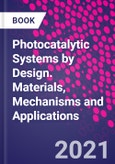Photocatalytic Systems by Design: Materials, Mechanisms and Applications explores various aspects of photocatalysis, including the photocatalytic phenomenon and process, applications, and the design of photocatalysts via band gap engineering. The book also covers band edge position engineering for multiple photocatalytic applications, such as pollutant degradations, hydrogen production, CO2 reduction into hydrocarbon fuels, antimicrobial disinfections, organic synthesis, N2 fixation, and more. This book is designed to enable beginners to learn the concepts and applications of photocatalysis. Unlike conventional books on photocatalysis, the book provides a 360� perspective into the field of photocatalysis and serves as an informative handbook for all audiences.
Please Note: This is an On Demand product, delivery may take up to 11 working days after payment has been received.
Table of Contents
1. Principle and mechanism of photocatalysis
2. Applications of photocatalysis: An Overview
3. Cation-modified photocatalysts
4. Anion-modified photocatalysts
5. Heterojunction-based photocatalysts
6. Defective photocatalysts
7. Z-scheme based photocatalysts
8. Plasmonic photocatalysts
9. Co-catalyst integrated photocatalysts
10. Ferroelectric photocatalysts
11. Metal organic framework-based photocatalysts
12. Carbon-based photocatalysts
13. Transition metal chalcogenides-based photocatalysts
14. MXenes-based photocatalysts
15. Photocatalytic memory/dark-photocatalysis/Round-the-clock photocatalytic systems
16. Photocatalytic membranes: synthesis, properties and applications
17. Photocatalytic ozonation for wastewater treatment
18. Novel photocatalysts for indoor air clean and healthy environments
19. Nanostuctured Semiconductors in Solar Light-driven Photocatalytic Fuel and Chemical Synthesis
20. Oxyhalide-based photocatalysts








